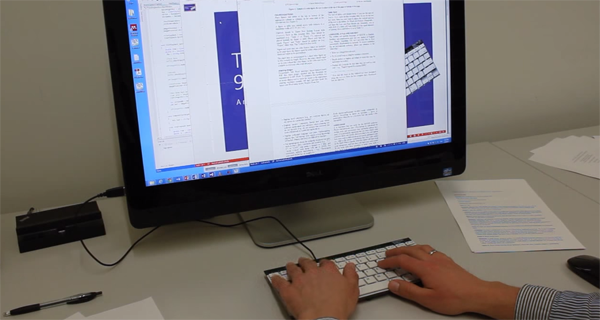Microsoft’s internal Research division has been operating behind the public eye for the last 23 years. In that time we have seen the department demonstrate some utterly insane projects as well as some innovative pieces of technology that have progressed to form the basis of a number of popular products and software solutions in existence today. Microsoft has been a little preoccupied recently with the acquisition of Finnish smartphone maker Nokia, but it seems its research team has still been beavering away and have now presented a new type of augmented mechanical keyboard.
The latest innovation from the Microsoft Research team takes the regular form factor of a standard mechanical keyboard. The team has then embedded a matrix of low-resolution infrared proximity sensors across the top of the keyboard to create a system that allows “rich and expressive motions gestures” to be detected both on and above the keys. The final prototype product looks remarkably like one of Apple’s beautiful wireless keyboards – more than likely due to the actual keys used being taken directly from an Apple product – and is intended to give users a new and interesting way to interact with their computers and connected devices.

One of the beautiful things about the prototype is the varying gestures that it can accept and interpret from users. Standard recognized gestures like pinch-to-zoom and basic swiping that we are all used to using on tablets and touch-screen computers form the foundation of the keyboard. However, additional power is provided in the fact that the keyboard can also detect gestures such as holding a single finger above the keyboard or circular motions that could suggest the user is pretending to interact with a steering wheel or similar. Potentially a very powerful companion product for desktop computing and gaming alike.
Microsoft Research has christened the prototype the “Type-Hover-Swipe” and is yet to confirm whether or not it has any intentions of actually turning the innovative solution into a real-world product. As a company, Microsoft is already leading the way in sensing and gesture technology with the Kinect sensor and this could be yet another step toward the end goal.
There’s no denying that the Type-Hover-Swipe is a great example of what is possible from a hardware perspective, but the underlying machine-learning algorithm that powers the hardware is also truly inspiring.
(Source: MicrosoftResearch)
You can follow us on Twitter, add us to your circle on Google+ or like our Facebook page to keep yourself updated on all the latest from Microsoft, Google, Apple and the web.

